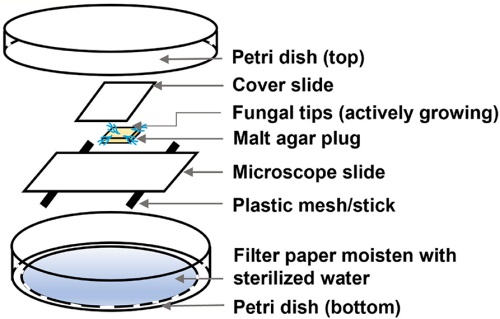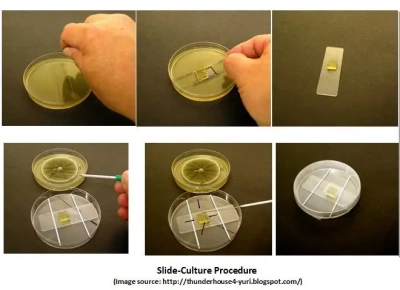Slide Culture for Fungi - Principle, Procedure, Advantage, Disadvantage
Introduction to Slide Culture for Fungi
Slide Culture for Fungi is a technique used for preparing fungal colonies for examination and identification with as little interference as possible. The undisturbed fungal growth remains identical to their growth on agar block.
Identification of fungi depends on the macroscopic features such as colony color, texture, growth rate, diffusible pigments, exudates, presence of aerial or submerged hyphae, and microscopic features including the arrangement of spores and non-sporing bodies.
Although other simple fungal identification methods such as the tease mount method can be done, it dislodges the conidia and spores.
Following this method removes the step of having to retain a portion of the fungi from a culture plate-like in scotch tape preparation/tape touch mount.
History of Slide Culture for Fungi
Slide Culture for fungi was first developed in 1950 by Riddel with the goal of preparing fungal colonies for examination with as little disturbance as possible. Since then several modifications of his method have been developed and used.
Principle of Slide Culture for Fungi
In Slide Culture for fungi, fungal isolates are inoculated directly on the slide containing small thin blocks of fungal growth media such as potato dextrose agar or cornmeal agar. The media is then covered with a coverslip and incubated.
Following incubation, the coverslip is gently removed from the media block and placed on another clean, grease-free slide containing a few drops of dye (Lactophenol Cotton Blue) and observed under the microscope. The addition of dye is optional.
Procedure of Slide Culture for Fungi
There are several procedures for Slide Culture for fungi. However, the basic principle of this method remains the same. The major difference between procedures is that some use agar plates as a base while others may use wet tissue or molten agar.
In the following procedure for Slide Culture for Fungi, steps 1 and 2 can vary while steps 3 and below are followed the same way.
Using a pair of sterile forceps, place a sheet of sterile filter paper in a Petri dish.
Place a sterile U-shaped glass rod on the filter paper and pour approximately 4 ml of sterile water on the filter paper to moisten it completely.
Place a sterile slide on the U-shaped rod.

Slide Culture for Fungi (Source: Adelaideu.edu.au)
OR
Place several layers of paper towel in a sterile culture plate.
Add two applicator sticks or sterile glass rods as a stand and place a sterile microscope slide on top.

Slide Culture for Fungi (Source: Frontiers)
OR
Aseptically, using a sterile scalpel, cut a block of suitable growth media of the desired dimension from a solid medium that has been previously poured into a petri dish of 2mm depth
* The block should be smaller than than coverslip
Gently remove the cut agar block and place it on the surface of the sterile microscope slide

Slide Culture for Fungi (Source: Thurnderhouse4-Yuri)
With the help of sterile right–angle wire, inoculate the four corners of the agar block with the test fungi
Place a sterile coverslip onto the surface of the inoculated agar block
Cover the petri dish with the lid and incubate at 30°C for 48 hours
* If growth is not visible after 48 hours, incubate for another 24-48 hours.
Carefully remove the coverslip and place it on another clean, grease-free slide containing a drop of lactophenol cotton or aniline blue.
Observe under the microscope to identify any characteristic shape and arrangement of spores.
Advantages of Slide Culture for Fungi
Slide Culture for fungi is a cheap and rapid method.
It reduces the chance of disturbing the fragile spore-bearing structures of the fungi hence allowing in-situ observation.
Disadvantages of Slide Culture for Fungi
Slide Culture for fungi cannot be done for dimorphic fungi such as H.capsulatum, B.dermititidis, C.immitis, P.brasiliensis or S. schenckii.
Fungal Cultures must be observed only after removing the coverslip and not while it rests on top of the agar block due to the chances of an accident resulting in laboratory-acquired infection.
In Slide Culture for fungi, the fungi can only survive for a short period due to their limited nutrient source. Hence, the identification of slow-growing fungi by this method is not approachable.